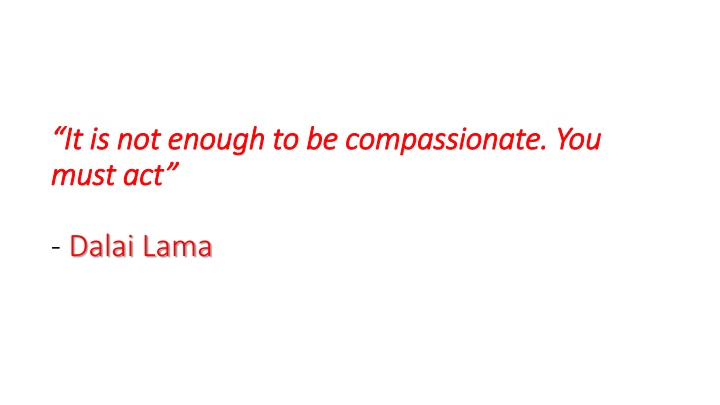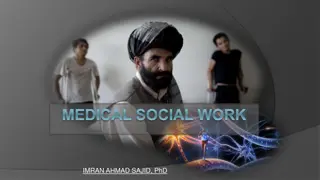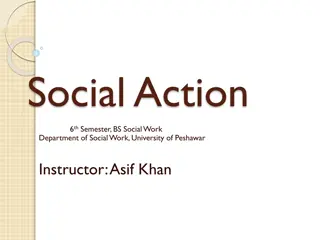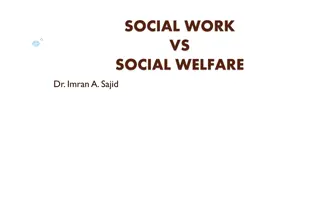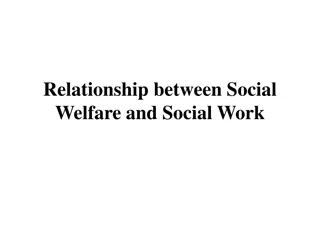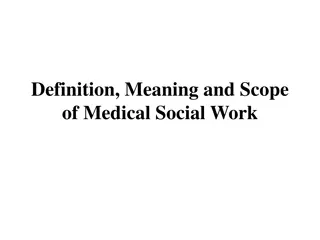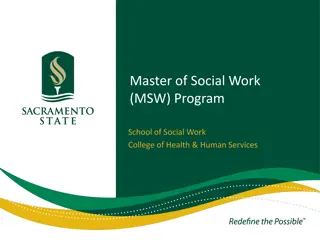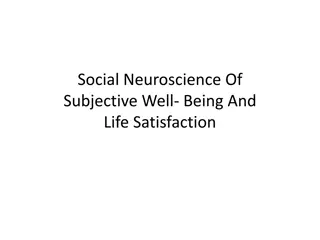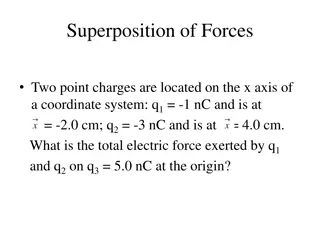Fields of Social Work in India: Overview and Roles
Social work in India is a diverse profession focusing on welfare across various settings. Social workers play crucial roles in hospitals, communities, and correctional facilities, ensuring individual and societal well-being. In health care settings, they provide services like crisis intervention, counseling, and case management while upholding values like self-determination and empathy towards clients.
Download Presentation

Please find below an Image/Link to download the presentation.
The content on the website is provided AS IS for your information and personal use only. It may not be sold, licensed, or shared on other websites without obtaining consent from the author.If you encounter any issues during the download, it is possible that the publisher has removed the file from their server.
You are allowed to download the files provided on this website for personal or commercial use, subject to the condition that they are used lawfully. All files are the property of their respective owners.
The content on the website is provided AS IS for your information and personal use only. It may not be sold, licensed, or shared on other websites without obtaining consent from the author.
E N D
Presentation Transcript
It is not enough to be compassionate. You It is not enough to be compassionate. You must act must act - Dalai Lama
INTRODUCTION TO SOCIAL WORK INTRODUCTION TO SOCIAL WORK UNIT UNIT- -III III Instructor: Abraham K Varghese Abraham K Varghese Assistant Professor & Head Department of Social Work The Bhopal School of Social Sciences
Fields of Social Work Fields of Social Work in in India India Introduction: Social work is a multi-disciplined profession which focuses on welfare in a holistic manner. Social work can be practiced in diverse fields like hospitals, asylums, communities, correctional settings etc. A social worker has to make sure that be in whatever field he works he brings in welfare; both of individuals and society as a whole. has to serve as a resource person who is dedicated for the welfare of the society. As the preamble of the NASW code of ethics say, The primary aim of social work is the well being of individual through capacity building and environment modification. A social worker in any circumstance and work setting should necessarily adhere to this principle.
1. Hospital 1. Hospital and Health Setting and Health Setting Social workers in health care settings provide a range of services including health care education, crisis intervention, supportive counseling and case management. Professional social workers turn inevitable to the medical settings owing to their holistic approach covering physical, emotional and environmental factors. The early concern of medical social workers was making heath care services available for everyone including the poor and eradicate diseases like tuberculosis but as the time passed on the areas of concern got broadened. While working in a medical setting the social worker should always stick on to the basic values of the individual s right to self determination and attitude of empathy towards the client.
Role and Responsibilities of a Social Worker in Role and Responsibilities of a Social Worker in Health Care Settings Health Care Settings 1. Integrate theory and practice: The social worker uses knowledge about, and psycho-social implications of, illness, injury, and health conditions to provide social work services to clients and families to help them manage and cope with the impact of such health matters. Social workers have expertise in communication; navigating systems of care, resources, client and family coping skills; and the comprehensive impact of health conditions on the client. Their areas of knowledge must include: the roles and functions of social work in health care the psycho-social needs of clients and families the psycho-social needs of clients and families the psychological and spiritual needs of clients and families and how to ensure that they can be addressed
community resources to assist clients and families laws, regulations, and policies affecting clients, families, and social work practice evidence-based practices and social work research in health care the needs of special populations. 2. Assessment and Intervention: Assessment is a fundamental process of social work practice. Treatment and intervention strategies/plans require that social workers both assess and reassess client needs and modify plans accordingly. Social work assessments in health care settings include considering relevant factors and the needs of the individual client and the family. The health status of populations and of individuals is assessed for many reasons. A comprehensive, culturally competent assessment includes:
past and current health status including genetic history of family health the impact of health conditions or treatments on cognitive, emotional, social, psychological, or physical functioning social history, including current living arrangement work, school, or vocational history stage in the life cycle and related and relevant developmental issues cultural values and beliefs, including views on illness, disability, and death family structure and the client s role within the family social supports, including formal and informal support systems behavioral and mental health status and current level of functioning, including history, suicide risk, and coping styles financial resources.
3. Intervention through Interdisciplinary Input: Intervention plans are steps identified by the social worker in collaboration with the client and with other members of the team to achieve objectives identified during assessment. Intervention plans include: Information, referral and education Individual family or group counseling Vocational, educational and supportive counseling Psycho-educational support groups Discharge planning 4. Addressing Client s Multiple Needs: Social workers has to maintain a therapeutic relationship with the client which includes linking the client with resources that provide a rage of services and opportunities to enhance successful quality outcome for the client. The range includes:
Physical assessment including diagnosis, intervention and treatment plans. Financial assessment, planning and intervention Case facilitation Client and family counseling Resource mobilization 5. Role as a Health Educator: A health educator strives to bring about the best possible state of well being. He/she helps families and individuals to promote health by their own actions and efforts. The health educator acts on the faith of inherent human potential to develop when suitable environment is created and opportunities are given. Health education is two fold with disease prevention and health promotion.
Areas of Practice in Health Care Social Areas of Practice in Health Care Social Work Work 1. In General and Specialty Hospital: The purpose of a medical social worker in a hospital setting is to help each individual sick person in matters of personal and social adjustments including rehabilitation in the society through the use of patient s capability as well as community resources. The role of the social worker in a hospital involves the following: Medical social worker acts as the doctor s mouthpiece and furnishes information to the client regarding the nature, cure, prevention and control of his/her sickness and ensures the patient s cooperation to doctor. Collects information about the patient s family, occupation, and cultural background and prepares his medico-social history. For the patients requiring hospitalization, the medical social worker helps in transition from home t hospital and vise versa.
The medical social worker works with the client and family and provides them emotional support and helps them with stress management. He explains to them, the changes that have to be made in the home conditions to benefit the client. He/she conducts group sessions for the inpatients and their attendants. He or she participates in all the field activities of the hospital. He obtains people s cooperation in multi-disciplinary camps. He/she arranges for financial assistance to the patients for treatment hospitalization, transportation etc. from welfare agencies. The medical social worker participates in teaching and training activities of the department of preventive and social medicine. He/she takes classes for medical, dental, nursing and pharmacy students. He/she actively participates in the research activities of the hospital Provides recreational services for the inpatients by organizing leisure activities.
2. In Psychiatric Settings: Social workers in the area of psychiatric health and substance abuse asses and assist in treating individuals with mental illness or substance abuse problems. Such service includes group therapy, outreach, crisis intervention, social rehabilitation and training in skills of everyday living. The social worker in the field of mental health and substance abuse are known as clinical or psychiatric social worker. Their role is vital in patient s well being which includes: The psychiatric social worker makes thorough study of the environment of the client enabling him/her to prepare a systematic case history of the client which throws light on the tension and difficulties in the client s life and also help him to assess the positive and negative aspects of the environment. The psychiatric social worker explains the client or relatives what the problem is and what is involved in psychiatric treatment. The social worker has to help the relatives of the mentally ill, to accept the diagnosis and the psychiatric recommendations. The social worker also tries to bring about a better adjustment between the client and his family.
To enlist the cooperation of other social agencies for better discharge of functions of one s own agency and for stimulating interest in dealing with common problems effectively. In prenatal and postnatal clinics and nursery schools the psychiatric social worker imparts mental health education to parents. Sometimes his/her services are required to promote mental health education in the community. The psychiatric social worker attached to hospitals has to respond to the problem of home sickness as well as the boredom of long treatment. S/he may organize a recreation club with the help of the members of the staff and the patients and encourage the latter to develop hobbies. Such activities contribute much to the patient s recovery.
2. Correctional 2. Correctional Settings Settings Mahatma Gandhi, the father of our nation, had once said Crime is outcome of a diseased mind and jail must have an environment of a hospital for treatment . This very statement signifies the importance of social work in correctional settings. Correction is one segment of criminal justice system by which the society seeks to protect the public, punish offenders, change behavior and in some cases compensate victims. The social work in correctional settings is concerned mainly with prisons and juvenile homes.
Prisons and Juvenile Homes: The Supreme Court of India has evolved three broad principles about the prisoners: a) A person in prison does not become a non-person. b) A person in prison is entitled to all human rights within the limitations of imprisonment. c) There is no justification in aggravating the suffering already inherent in the process of incarceration. A social worker in a prison setting should keep in mind these principles and work for the transformation of prisoners. Social worker can serve in juvenile homes as well as observation homes by way of group work or social case work with the client; juvenile, in this case is helped to develop an understanding of his problem, look at the resources available to him and involve them in the decision pertaining to them. Involving community in activities of children such as celebration of some important days or cultural activities is also undertaken.
Activities off the social worker in Correctional Settings Activities off the social worker in Correctional Settings 1. Counselling: It is a relationship in which one endeavour to help another understand and solve his problem of adjustment. It is distinguished from advice or admonition in that it implies mutual consent. It has as its goal the immediate solution of a personal problem or long range effort to develop self understanding and maturity. 2. Insight and Empathy: Perceptive understanding is required on the part of the social worker who develops insight into the problem of the client/offender by empathy. Empathy is a critical ingredient in the therapeutic process getting into the client s frame of reference. 3.Interviewing: Interviewing is a professional conversation with a purpose. Effective communication is at the heart of positive human interaction. Interviewing is different from intense psychotherapy and counselling. Interview is basic while counselling is the epitome of positive guided interaction.
In correctional setting there are a few issues which must In correctional setting there are a few issues which must be kept in be kept in mind: mind: 1. The captive client: In correctional settings the client, because of the constrained setting, is captive. Presence during the sessions is not voluntary and somewhat imposed. Hence it is a very responsible process and the whole environment should be lighthearted. There is needed a structured permissive relationship between the client and interviewer. This relationship should allow the client gain an understanding of himself to a degree which enables him take positive step in the light of a new environment. 2. Stigma and self esteem: Oxford Dictionary describes stigma as a mark of disgrace . It should be kept in mind that becoming an offender and coming in conflict with law has a deeper impact on the self esteem of the client, as the society treats them as marginalized and stigmatized. Sometimes the client internalize the stigma and behaves in a very different way (defensive or abusive) Hence the social worker has to keep these factors in mind before entering into any kind of intervention with them.
3. Unorganized 3. Unorganized Sector The National Commission for Enterprises in the Unorganized Sector s reports (2008) on Definitional and Statistical Issues relating to the Informal Economy defines unorganized sector and worker as: Informal Sector: The unorganized sector consists of all unincorporated private enterprises owned by individuals or households engaged in the sale and production of goods and services operated on a proprietary or partnership basis and with less than ten total workers . Informal worker/employment: Unorganized workers consist of those working in the unorganized sector or households, excluding regular workers with social security benefits provided by the employers and the workers in the formal sector without any employment and social security benefits provided by the employers Sector
Features of Unorganized Sector: 1. Casual nature of employment 2. Ignorance and illiteracy 3. Small size of establishments with low capital investment per person employed 4. Scattered nature of establishments 5. Superior strength of the employer operating singly or in combination
Categories of Unorganized Labour: 1. Contract labour including construction workers 2. Casual labour 3. Labour employed in small scale industry 4. Handloom/power-loom workers 5. Beedi and cigar workers 6. Employees in shops and commercial establishments 7. Sweepers and scavengers 8. Workers in tanneries 9. Tribal labour 10. Other unprotected labour
Role of Social Workers in Unorganized Role of Social Workers in Unorganized Sector Providing Legal Aid: In Unorganized sector the people involved are often illiterate or have less knowledge about the legal matters. A social worker has the responsibility to make necessary arrangements to equip them with rightful legal aid. Advocacy for Working Rights: The unorganized worker has every right to do his job devoid of any external pressures. Any activities that seemingly curtail the same must not be promoted. Social worker has to ensure that the working rights of the labourers are in tact. Any sort of workplace stress and harassment must be taken up seriously. Awareness Generation about Various Legislations: A social worker has to be well informed about the legislations regarding the informal workers he d eal with. For instance if he works among the handloom workers he has to know the provisions and law regarding them and make them aware about such laws and provisions. Sector
Intervention to Improve the Living Conditions: It is the duty of the social worker to create awareness about the necessity of improving living standards. He has to create awareness about the importance of hygiene, sanitation etc. He has to ensure that people do take care of their health and cleanliness. Awareness Generation about Substance Abuse: Informal labourers are one of the groups vulnerable to substance abuse. Social worker must create awareness about the hazards of substance abuse among them and earnestly strive to eradicate such tendencies.
4. 4. Environmental Issues Environmental Issues Mahatma Gandhi said, What we are doing to the forests of the world is but a mirror reflection of what we are doing to ourselves and to one another. Concern for environmental justice has increased in recent decades. Although the environmental justice field is closely linked to social justice, the social work profession has yet to gain a substantive involvement in environmental justice efforts.
The U.S. Environmental Protection Agencys (EPA) definition of environmental justice establishes it as a social justice issue: environmental justice is the fair treatment and meaningful involvement of all people regardless of race, colour, sex, national origin, or income with respect to the development, implementation, and enforcement of environmental laws, regulations, and policies (U.S. EPA). Social work has a realistic and evidence-based understanding of social justice as well as a commitment to serve society s most vulnerable populations and hence social work should necessarily focus on environmental issues too.
Areas of Environmental Concern and Role of Social Worker Areas of Environmental Concern and Role of Social Worker Destruction of Natural Resources: Destruction of natural resources is a wide area of concern which includes deforestation, depleting ground water sources and issues of such sort. A social worker concerned with such fields should assure that such issues don t arise from ignorance. He has to make sure that people are well informed about the dangers of such activities. He has to organize awareness programs on the same and assist in resource allocation; the absence of which is often the cause of such practices. Global Warming and Climate Change: Global warming and climate change are the outcome of human selfishness. The production of green house gases from vehicles result in global warming. The ultimate aftermath of the same is submerging of low lying areas. Thus global warming is an act of social injustice as it will leave millions of people homeless in the long run; even Maldives are under the same threat. A social worker has to consider this issue as a social justice issue and create awareness among the urban community regarding the use of public transport and not being over dependent on chemical products like aerosols.
Toxic material production and waste disposal: One of the major environmental problems in industrial cities and associated slums is waste disposal. Often factories produce a large amount of toxic waste and directly dispose to nearby rivers or land. This besides creating serious environmental imbalance leads to lethal diseases to the people living in nearby slums and associated areas. Taking into consideration both the factors a social worker should make factory labourers about the dangers of the same and organize the labour community against such deeds. He should also ensure that environmental laws are not violated.
Air, Land and Water pollution: The most fearsome environmental problem of the times is pollution. Pollution is the outcome of industrialization and associated developments. This can be tackled only at the base. A social worker practicing in any community must ensure that pollution is under control in his area of concern. Once he succeeds in making this possible, pollution rate will start falling gradually. A social worker has to succeed in making people aware about the hazards and making them to practice measures against pollution. Species extinction: All animals have equal right upon this earth to survive as a man has and also they play a vital role in maintaining the balance of the ecology. Social workers in tribal settings has to ensure that people know the worth of every species and prevent them from poaching. In case of poaching from external sources he has to make sure that concerned authorities are reported and the offenders receive deserving punishment.
INTRODUCTION TO COMMUNITY DEVELOPMENT INTRODUCTION TO COMMUNITY DEVELOPMENT Community? Maclver defines community as "an area of social living marked by some degree of social coherence Man cannot live or exist alone, He is connected in many ways to his fellows who form a group. Man could not become the member of all the existing groups. He can establish and maintain relations only with the people who inhabit near him in a certain part of the territory. The people who over any duration of time inhabit in a particular locality should develop social likeliness, should have common social idea, common traditions and the sense of belongingness. All these common factors give birth to community.
Definitions of Community Definitions of Community According to Maclver: Community is "an area of social living marked by some degree of social coherence" According to Lundberg - "Community is a human population living within a limited geographical area and carrying on a common inter dependent life. According to Bogardus "Community is a social group with some degree of we feeling and living in a given area."
Characteristics of Community Characteristics of Community Group of people: Community is a group of people. Locality: The group of people forms a community when it begins to reside in a definite locality. Sentiments or Belongingness: The belongingness means feeling of community sentiments that developed among community people while residing together. Permanency Community is unlike crowd. it basically includes a permanent life in a definite place.
Not made by act of will - Communities are not made or created by an act of will but are natural. Commonness- Community shares common language. Customs, mores etc. Specific Name :- Every community have some specific name. Wider ends In communities the people a associate not for the fulfillment of a particular end. The ends of a community are wider. These are natural and not artificial.
Difference between Society Difference between Society and and Community Community Society includes every relation which is established among the people, society has no definite boundary infect it is universal. Community is the group of people who live together in a specific area or locality and share common life. Society is the name of our social relationship on the contrary community is the group of people living together is a particular locality. The community people also have community sentiments. Society is a web of social relationship which cannot be seen or touched. Community is the part of society and exists within society and possesses its distinguishable structure which differentiates it from other communities. Society is an abstract concept on the contrary community is a concrete concept. It is a group of people residing together in a geographical area having a sense of belongingness.
Community D Community Development? evelopment? United Nations defines Community Development as "a process where community members come together to take collective action and generate solutions to common problems. It is a broad concept, applied to the practices of civic leaders, activists, involved citizens, and professionals to improve various aspects of communities, typically aiming to build stronger and more resilient local communities. CD is a practice-based profession and an academic discipline that promotes participative democracy, sustainable development, rights, economic opportunity, equality and social justice, through the organization, education and empowerment of people within their communities, whether these be of locality, identity or interest, in urban and rural settings"
Community development seeks to empower individuals and groups of people with the skills they need to effect change within their communities. These skills are often created through the formation of social groups working for a common agenda. Community developers must understand both how to work with individuals and how to affect communities' positions within the context of larger social institutions.
Different approaches of Community Development Different approaches of Community Development There are numerous overlapping approaches to community development. Some focus on the processes, some on the outcomes/ objectives. They include: Community Engagement: focuses on relationships at the core of facilitating "understanding and evaluation, involvement, exchange of information and opinions, about a concept, issue or project, with the aim of building social capital and enhancing social outcomes through decision-making Women Self-help Group: focusing on the contribution of women in settlement groups Community capacity building: focusing on helping communities obtain, strengthen, and maintain the ability to set and achieve their own development objectives. Social capital formation: focusing on benefits derived from the cooperation between individuals and groups
Large Group Capacitation: an adult education and social psychology approach grounded in the activity of the individual and the social psychology of the large group focusing on large groups of unemployed or semi-employed participants, many of whom with Lower Levels of Literacy (LLLs) Nonviolent direct action: when a group of people take action to reveal an existing problem, highlight an alternative, or demonstrate a possible solution to a social issue which is not being addressed through traditional societal institutions (governments, religious organizations or established trade unions) to the satisfaction of the direct action participants. Economic development: focusing on the "development" of developing countries as measured by their economies, although it includes the processes and policies by which a nation improves the economic, political, and social well-being of its people. Community economic development (CED): an alternative to conventional economic development which encourages using local resources in a way that enhances economic outcomes while improving social conditions. For example, CED involves strategies which aim to improve access to affordable housing, medical, and child care.
Sustainable development: which seeks to achieve, in a balanced manner, economic development, social development and environmental protection outcomes Community-driven development (CDD): an economic development model which shifts overreliance on central governments to local communities. Asset-based community development (ABCD): is a methodology that seeks to uncover and use the strengths within communities as a means for sustainable development Faith-based community development: which utilizes faith-based organizations to bring about community development outcomes. Community-based participatory research (CBPR): a partnership approach to research that equitably involves, for example, community members, organizational representatives, and researchers in all aspects of the research process and in which all partners contribute expertise and share decision making and ownership, which aims to integrate this knowledge with community development outcomes
Community organizing: an approach that generally assumes that social change necessarily involves conflict and social struggle in order to generate collective power for the powerless. Participatory planning including community-based planning (CBP): involving the entire community in the strategic and management processes of urban planning; or, community-level planning processes, urban or rural. Town-making: is "an umbrella term generally understood as citizen participation in the planning and management of a living environment" It can include redevelopment, revitalization, and post-disaster reconstruction, and usually emphasizes the importance of local citizen participation. In recent years, cooperation between local communities and contents tourism Methodologies focusing on the educational component of community development, including the community-wide empowerment that increased educational opportunity creates.
Rural Community Development Rural Community Development The earliest human communities were perhaps the loosely organized aggregations of a few facilities that carried on mutually interdependent activities in gathering food and defending themselves against their enemies. Gradually man acquired skills and knowledge in agriculture food and begin to live settled life in villages. It is difficult to define villages but generally it is understood as a small area with a small population which follows agriculture not only as an occupation but also as a way of life.
Rural areas are often remote settings devoid of mainstream attention and hence lacks development in multiple sectors. As a result rural areas require services in the following areas: Job and economic problems Alcohol and drug problems of adults and youth Lack of constructive leisure-time programs and facilities Marriage and family problems Personal stress, anxiety, depression Infrastructure development
Characteristic Features of Village/ Rural Communities Characteristic Features of Village/ Rural Communities The rural community marked by several features the important one are the following :- Community Consciousness: The dwellers of rural community have a sense of unity. The relation between the people is intimate. They personally know each other customs and traditions. Role of Neighborhood: - In rural community neighborhood plays a important role. These is not enough individuality and people pay attention to their neighbor in his sorrows and joys in the village people assist each other and thus they have closest neighbourhood relations. Joint Family :- In rural communities we can still see very strong joint family system. People live together in a close tie with their brothers and sisters. The agriculture occupation also requires the cooperation of all the members. Faith in Religion :- The rural people have deep faith in religion and deities. Their main occupation is agriculture which largely depends upon the change of nature. The rural people acquire an attitude of fear and respect towards natural forces and start worshipping them. Simplicity: - The rural people live a simple life and remain far away from the evils of modern civilization generally they are simple people believing in God. Their behavior is natural not artificial and they live a peaceful life.
A rural social worker is described as a generalist who brings to bear a broad range of methodologies and skills in practice for the development and welfare of the community. The rural social worker need to understand both the positive and negatives of working in small rural communities. Some important positive elements are: Inter agency cooperation A sense of community Positively responding community Some negative elements are: Geographic isolation Personnel isolation Service isolation
Roles of a Rural Social Worker Roles of a Rural Social Worker Direct Service Role: Rural social worker deals with individuals, couples, families and groups. Rural social workers need to convey to the community the fact that social work is a valuable resource to every community member. Resource Specialist: One of the most difficult roles the rural social worker assumes is that of assisting in the optimal utilization of the limited resources available in many rural areas. It requires imagination and creativity to put together resources in order to serve human needs effectively. Social Service Administrator and Community Organizer: Most rural communities have few professional people and rural social workers usually find themselves in the role of trying to coordinate all the social services in the community. The rural social worker needs to be able to relate to the power structure of the community.
Urban Community Development Urban Community Development Generally by an urban area we mean an area with high density of population which characterized by its size heterogeneity, social differentiation and stratification, mobility, environment and system of interaction. The census of India 2011 defines urban area as follows:- All places with municipality, corporation, cantonment board or notified town area committee etc. All other places which satisfied the following requirements: A minimum population of 5000 At least 75% of the working population engaged in non-agriculture pursuits and A density of population at least 400 persons per square kilometer.
Characteristics/Features Characteristics/Features of Urban Community: of Urban Community: Namelessness According to the observations of Bogardus urban communities have a reputation for namelessness. By virtue of its size and population there cannot be a primacy group. The members of a city do not come into primary contact with each other usually they met and speak without knowing each others name, basically life of the citizens of a city are mechanical. A citizen may live for several years in a city and may not know the names of one third of the people who live in the same city area. Homelessness Homelessness is another distinguish feature of city community. The problem of shelter in a city is very common and many people pass their life homeless in city and are forced to live in slums. Class Extremes Class extremes characterize urban community. In a city one can find the richest as well as the poorest people, the people rolling in luxury and living in a grand mansion as well as the people leaving on pavement and hardly getting two meals a day. Social Heterogeneity: - The urban areas are more heterogeneous than the rural areas. We can see a cosmopolitan culture and melting pot of races, people and culture and is a most favorable breeding ground of new biological and cultural hybrids.
Social distance: - Social distance an urban area is mainly focused due to anonymity and heterogeneity. The city dwellers feel lonely. Most routine contracts are impersonal and segmented, formal politeness takes the place of genuine friendliness. Energy and Speed :- Residual of urban area work with tremendous energy and speed day and night which stimulate other also to work, similarly in urban areas people indulge in too many activities and inconceivable efforts, urban life also produces greater emotional tension and insecurity that is unlike rural communities.
Urban Social Issues Urban Social Issues Housing Homelessness Pollution Mental Health Problems Public Education Crime lack of job opportunities & Unemployment Gender inequality Discrimination Urban Sprawl Slums and Squatter Settlements Safe water issues Sewerage/Sanitisation/un-hygiene Problems
Urban communities witness a cosmopolitan culture unlike the rural communities. People from different backgrounds and contexts reside together. People in such areas belong to different classes, caste, creed, religion etc. An urban social worker has to be aware about such differences in cultural context. According to recent statistics from the World Health Organization (WHO), more than 50% of the world s population lives in an urban area, but this is predicted to grow to 70% by the year 2050. With such densely populated areas, urban environments are more likely to experience large disparities in socioeconomic status, higher rates of violent crimes, and increased presence of marginalized populations.
Urban communities are also associated with higher prevalence of psychological stress that are the direct result of increased density in cities. Since there are a higher percentage of persons of lower socioeconomic status in urban areas, these populations often face barriers to receiving quality social services due to a lack of health insurance and/or undocumented citizenship. Even more worrisome, financial obstacles that prevent the basic access to quality social services, health care, and education often perpetuate the vicious cycle of poverty from generation to generation.
While there are endless opportunities available in cities, vast population disparities often lead to a two- tiered social service system where insured individuals have access while marginalized populations lack needed care. Here comes the role of social worker who has to work for the marginalized majority. He has to assure that the citizens living in the slums and outskirts of cities have access to resources like health care, education and human rights.
